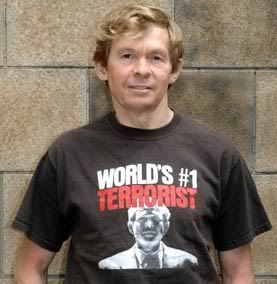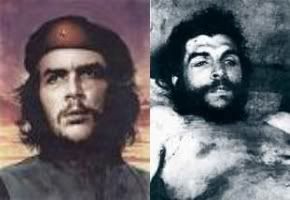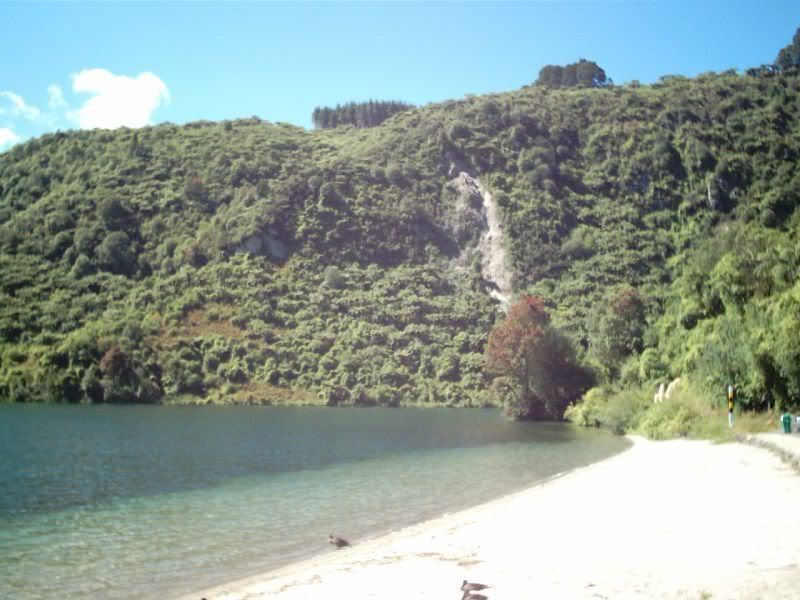Mexican Gunmen Involved in Arizona Border Incident Actually Uniformed Mexican Force
By Heidi at Euphoric Reality The excursion into U.S. territory last week by "Mexican gunmen" was not a chance confrontation between the Arizona National Guard and untrained illegal immigrants, but a deliberate "perimeter probe" by an infantry-trained, uniformed Mexican force, officials say.
Euphoric Reality has learned in exclusive interviews with high-ranking sources within both the Arizona National Guard and the U.S. Border Patrol that the incident the mainstream media calls a "standoff" was in reality a military-style operation, carried out by a unit of Mexican troops dressed in military uniforms, flak jackets, and armed with AK-47s in an apparent operation to probe the border defenses and test the limits of the National Guard troops. Using easily recognizable infantry movement tactics (such as arm and hand signals and flanking maneuvers), the Mexican unit deliberately moved in a military formation across the border from Mexico , where they were picked up by National Guard surveillance.
As the hostile force moved north over the next three hours, deeper into Arizona, National Guardsmen wearing night vision goggles were able to ascertain that the approaching gunmen were indeed uniformed (including PAGST helmets) and heavily armed. When the Mexican unit came within approximately 100 yards of the EIT site, the Guardsmen repositioned themselves in order to maintain surveillance and tactical advantage. They observed the Mexican unit sweep through the EIT site, and then rapidly withdrew back into Mexico . No shots were fired by either the Mexican gunmen or the Guardsmen. Border Patrol was on the scene within minutes of the Mexican unit's withdrawal.
The Guardsmen, through an Arizona Border Patrol official, confirmed that the incident appeared to be an intelligence-gathering exercise designed to ascertain what the National Guard's response would be to certain tactics. It is not an isolated incident, and many such probes have been reported by the Guardsmen assigned to the area. Though no shots were fired during this particular incident, shots have been fired near and in the vicinity of the soldiers at the EIT site in other situations, though not at the soldiers themselves. It is not clear from the uniforms if the Mexican soldiers were official Mexican federales or mercenaries hired by the drug cartels.
Since then, follow-on news reports have included statements from the Border Patrol that no shots were fired. This was confirmed today by Major Paul Aguirre, a Public Affairs Officer (PAO) for the Arizona National Guard. Rumors have circulated that the Guardsmen were not armed, and thus unable to defend themselves - and that is not the case. Both Major Aguirre and Rob Daniels, a Public Information Officer (PIO) for the Arizona Border Patrol, state that all Guardsmen assigned to EITs are armed, specifically with M16s and sometimes a sidearm. As well, there have been some contradictory news reports that stated the gunmen came "within yards" of the Guardsmen, while other reports state that the gunmen were approximately 100 yards away. Mr. Daniels clarified that the gunmen came as close as 100 yards to the Guardsmen. He also stated that the Guardsmen did not "retreat" but tactically repositioned themselves to maintain surveillance of the group of armed men while simultaneously radioing for Border Patrol agents. He asserted that the Guardsmen had followed their protocols perfectly, and that their services were invaluable to the Border Patrol agents.
The Myth of Troops Bringing Law Enforcement to the Border
National Guard soldiers on the border are volunteers deployed by the federal government for Operation Jump Start. They are not mandated to perform law enforcement activities and, in fact, are prohibited from doing so under the Posse Comitatus Act while federally deployed. They are assigned to the border mission for the sole purpose of supporting the Border Patrol - mostly performing administrative, engineering, and maintenance duties that free up Border Patrol agents for border enforcement.
The ramifications of this incident hitting the public awareness are significant. There are incidents on the record of specially-trained military commandos attacking Border Patrol agents, and videos in existence of uniformed Mexicans, deep in American territory, claiming to be reporters when confronted by Arizona Minutemen. Hundreds of armed incursions have been documented by the Border Patrol. In one year, June 2005 until June 2006, over 250 armed assaults have been reported by Border Patrol agents, and several agents have been killed.
Michael Chertoff, head of Homeland Security, has gone on the record to dismiss reports of armed incursions by a uniformed military force as "navigational mistakes", claiming that the Mexican soldiers were "lost." However, Chertoff offered no explanation as to why these "lost troops" fired on American agents. The Mexican government claims that uniformed military soldiers coming from Mexico are actually American soldiers disguised as Mexican soldiers. Furthermore, when confronted with the possibility that Mexican commandos called Los Zetas, trained by U.S. Special Forces at Fort Bragg to support the Drug War, have defected from the military and now work as mercenaries for the drug cartels, Mexican officials have worked very hard to debunk such evidence. In an official report presented to the U.S. on behalf of the Mexican Office of Inter-Intelligence Affairs, Mexico claimed that "the Zeta army, or syndicate, is no more real than the crying lady of Puebla ."
Yet, contrary to Mexican denials, Los Zetas do exist, and the U.S. Border Patrol is very familiar with them. In a June 2006 investigative news piece by News Channel 5 in Texas, Zetas discussed their training and murderous missions. They also issued a warning:
"These two members of the Zeta army also have a warning for American law enforcement: They are here, with cells operating in Roma, Rio Grande City and Mission - and more are coming.
'It is not a lie,' Zeta-2 said. 'They need to check good, because it is true.'"
Los Zetas: Guns Gone Bad
During the 1990s, U.S. Army Special Forces trained a number of Mexican federal agents and army units in special warfare tactics as part of an effort to aid the struggling Mexican government in the Drug War involving the violent drug cartels of northern Mexico . It's been said that "the training was remedial in nature, and did not exceed international peace time law of NATO forces training foreign combat forces in tactical warfare." Lest we worry about the operational proficiency of such mercenaries, Wikipedia has this unattributed entry:
"The training lasted a mere three months in the sweltering North Carolina heat. In total, 300 Mexican agents and army officers participated in the summer long exercise. Years later, unsealed documents revealed that the training proved to be no more than an extended boot camp. "It was more a media and propaganda effort then it was for actual tactical training that could be used in combat," one of the US Special Forces Officers that participated in the effort stated. "They brought them [sic] boys here, and most of them could fire a gun already, so we just showed them a lot of video of Special Forces training from the early 70's. We were not about to teach or display tactics that make Special Forces what they are. That's why when I read that these boys that are 'Zetas' were Special Forces trained, I almost wet myself with laughter.'"
What the Zetas may lack in professional specialized training, they make up for in ruthless and savage violence. Last year, Times Magazine exposed much of the brutality in an article called Brutal New Drug Gangs Are Terrorizing The U.S.-Mexico Border, and added further information about the identity of Los Zetas.
"According to Mexican officials, Lazcano was a clean-cut Mexican army recruit from the Gulf Coast state of Veracruz when he was picked a decade ago to be part of the highly trained Airborne Special Forces Group. The unit was sent to the eastern border to battle drug trafficking. But in the late 1990s, Lazcano and more than 30 other members of the special forces began working for drug lord Osiel Cardenas, head of the Matamoros-based Gulf cartel, which at the time controlled almost one-third of the Mexican drug trade. "
Official Mexican propaganda notwithstanding, it can be safely assumed that the Zetas are a paramilitary force that has made regular incursions over our border in sometimes heavily-armed assaults. Whether they are actual Mexican federales or uniformed mercenaries in the employ of the drug cartels remains to be seen. Perhaps a small clue to the uniforms is found in the News Channel Five investigative report:
"'The municipal police, the state police, the ministerial police, the police of the state,' Zeta-1 said. 'The soldiers and the federal preventive police. The military on the border. They are bought by the Zetas.' The Zeta's tools even include uniforms given by the police themselves."
Regardless of who the uniformed soldiers are, or who commands them, what is paramount is that our southern border security is breached by foreign troops on an increasingly aggressive basis. While our National Guard troops are effectively hamstrung by political restrictions, foreign military soldiers press the advantage. Border Patrol agents have already given their lives in a heroic effort to guard our border, and it is only a matter of time before we lose American soldiers. Is that what it will take for our government to finally take the matter of border security seriously? This is no longer a matter of local civilian law enforcement; it is a matter of national security. For politicians, no matter their affiliation, to play partisan games with our national safety and security is a betrayal of their constituents' trust, and the constitutional duties of their office.
Hat-tip: Vilmar















